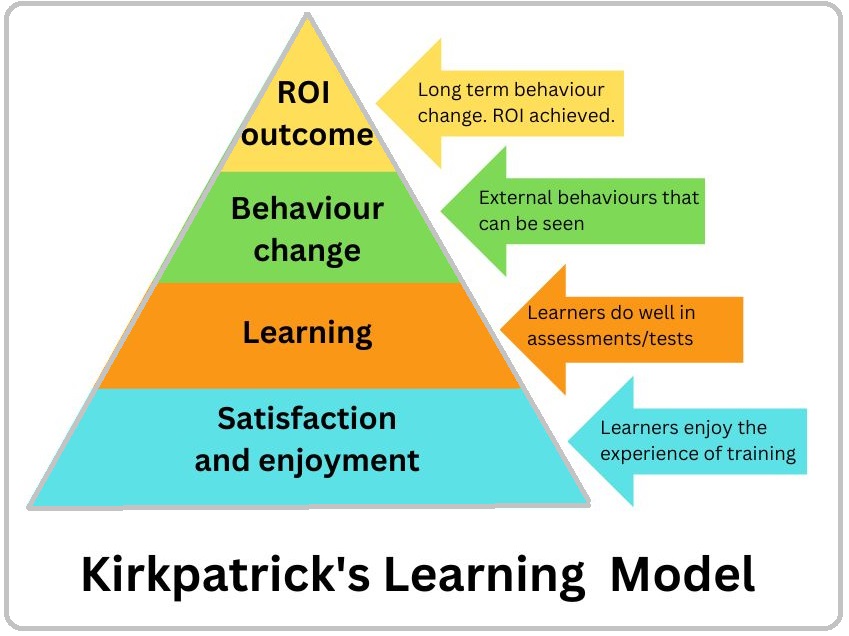It’s useful to have a learning model in mind when investing or attending training. Here’s some information about the Kirkpatrick model. It’s clear and rather beautiful in its simplicity.

Kirkpatricks Learning Model
Kirkpatrick’s model is not specifically about learning styles. Instead, it’s a widely used framework for evaluating training programs and assessing their effectiveness. The Kirkpatrick Model was developed by Donald L. Kirkpatrick in the late 1950s and has since been widely adopted in the field of training and development. It consists of four levels of evaluation, each building upon the previous one to provide a comprehensive analysis of a training program’s impact.
Kirkpatrick’s Four Levels of Evaluation: Enhancing Training Effectiveness
The Kirkpatrick Model offers a structured approach to assess the effectiveness of training programs across four distinct levels. These levels provide valuable insights that help organizations improve their training strategies and ensure that learning initiatives align with organizational goals.
Level 1: Reaction
This level focuses on participants’ immediate reactions to the training program. This involves collecting feedback through surveys, questionnaires, or informal discussions to gauge learners’ thoughts and feelings about the training content, delivery methods, and overall experience. While this level doesn’t provide direct insight into learning outcomes, it helps trainers identify potential areas of improvement in terms of engagement, clarity of content, and training logistics. Often known as the “Happy Sheet” amongst trainers. We want your people to have fun, afterall.
Level 2: Learning
At the second level, the focus shifts to assessing participants’ actual learning outcomes. This involves evaluating the extent to which participants have acquired new knowledge, skills, or competencies as a result of the training. Various assessment methods, such as quizzes, tests, and skill demonstrations, can be employed to measure learning outcomes accurately. By analysing the learning achieved, organizations can determine if the training content is effective and relevant.
This can be undertaken within the training, and the training can be adjusted. As a trainer, I’m regularly checking in with assessing the room, either by interest, or by little tests, questions, asking people to respond.
Level 3: Behavior
Level 3 evaluation delves into how the newly acquired knowledge and skills are applied in the participants’ workplace. This level examines whether the training has led to observable changes in behavior, job performance, and task execution. Collecting data through supervisor assessments, performance appraisals, or direct observations helps organizations understand whether the training is translating into real-world improvements.
Now, this can be a little more tricky to identify in the training room, after all it’s about workplace behaviour. So that’s where it helps to have a close relationship with the L&D department, and an ongoing programme. Having said that, we trainers can also future-pace learning – asking learners what they will take forward into their workplaces, what changes they want to see.
Level 4: Results
The ultimate goal of any training initiative is to drive positive organizational outcomes. Level 4 evaluation focuses on assessing the impact of the training on business goals and outcomes. This could include increased productivity, improved quality of work, enhanced customer satisfaction, and more. By correlating training results with organizational performance metrics, organizations can determine the tangible benefits of their training efforts and make informed decisions about the allocation of resources.
OK, this is certainly the most important part of training, but it isn’t always easy or possible to assess in the training room. However, by using future pacing, and ensuring that learners are feeling heard and relevant for the organisational culture, it can mean they are more aligned with the overall organisational aims and objectives. Future-pacing, assessing, and asking perspective questions around “how will this impact on the whole organisation” can help.
The Importance of Kirkpatrick’s Model
Kirkpatrick’s Model provides a systematic approach to training evaluation that enables organizations to make data-driven decisions. By assessing training programs at each level, organizations can identify strengths and

Kirkpatricks Learning Model
weaknesses, make necessary adjustments, and maximize the return on their training investments. This model emphasizes the need to move beyond the surface-level reactions of participants and delve deeper into the actual learning outcomes and subsequent behavior changes.
In conclusion, the Kirkpatrick Model offers a comprehensive framework for evaluating the effectiveness of training programs. By considering participants’ reactions, learning outcomes, behavior changes, and organizational results, organizations can refine their training strategies and ensure that learning initiatives contribute to overall business success. While the model doesn’t specifically address learning styles, it does emphasize the importance of assessing various aspects of training to create a holistic view of its impact.
For more information on the model itself: https://www.kirkpatrickpartners.com/the-kirkpatrick-model/


